14 Ways To Use Your Mandoline That You've Probably Never Thought Of
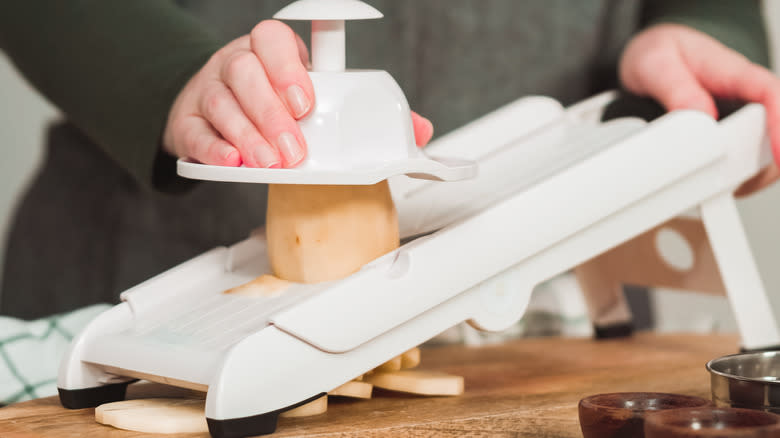
How often do you use your mandoline? We'd wager it's probably not as often as you could. Mandolines are somewhat niche kitchen utensils, but they can be used for more than you think. When utilized correctly, these contraptions, which consist of a sharp blade mounted on a flat surface, can produce ultra-thin slices of everything from your favorite cheese to hard-boiled eggs. Mandolines can also be incorporated into recipes that you'd normally use a knife for; they're particularly handy when working with caramelized onions.
Mandolines also give your food uniformity, producing an equally sized slice every time. This gives your meals a pleasing aesthetic, and also ensures that everything cooks at the same pace. When used correctly, they can slice items far quicker than a simple knife can. The momentum that you gather when using a mandoline also helps process firmer items, like meats and cheeses, more cleanly. What's more, this is really just the beginning of a mandoline's usefulness. We're taking a look at all the ways you can use it that you've probably never thought of.
Read more: 8 Baking Sheet Mistakes You Want To Avoid
Slice Fruit For A Charcuterie Board Spread
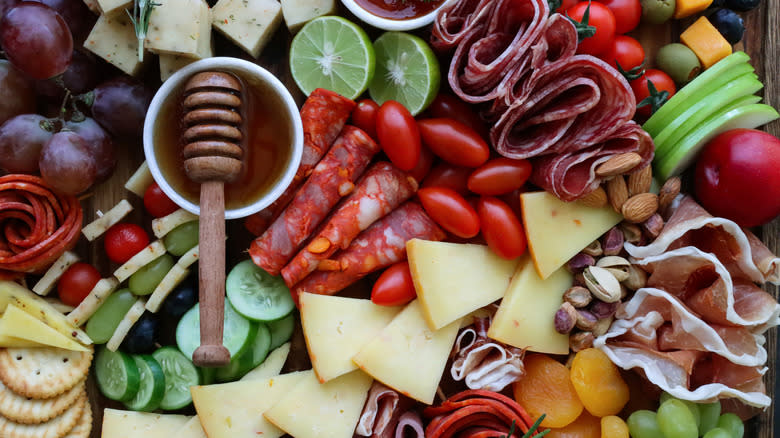
Mandolines are most commonly used to slice vegetables, but don't forget about fruits. Firmer fruits, like apples, pears, just-ripe peaches, and citrus fruits, can all be sliced using a mandoline. Doing this produces the regular slices that are key to a well-designed and organized charcuterie board; these slices can either be eaten or used as decoration. When slicing your fruit, it's important to remove any cores or stones before doing so. Leaving them in can blunt your blade, cause your fruit to be sliced off-center, or give your guests an unfortunate mouthful of fibrous, tough material.
It's not just your charcuterie board's fruit that you can slice using your mandoline, either: You can also slice your cheese with it. Medium-hard cheeses like cheddar, and hard cheeses like parmesan or grana padano, are all well-suited to this utensil. By using the same mandoline for your fruit and cheese, you can ensure that each bite is balanced. It's best to avoid trying to slice soft cheeses using your mandoline, though, as this will just clog it up and require annoying clean-up afterward.
Make Zoodles With Your Mandoline
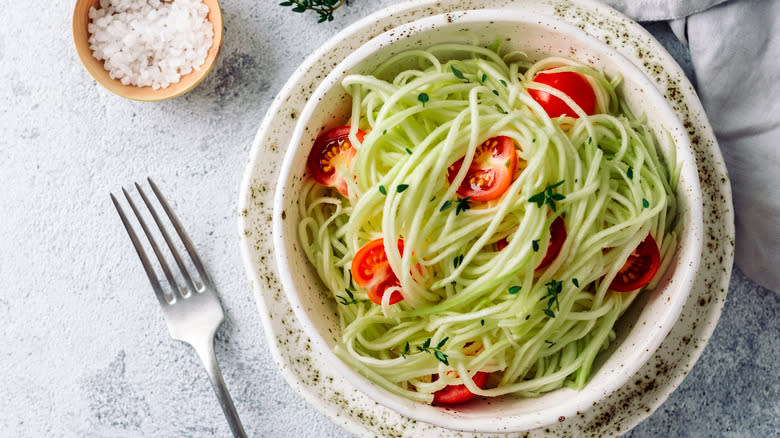
Zoodles are most commonly made with a spiralizer. We understand why: Using one of these utensils gives you ultra-long and impressively regular zucchini noodles. They're also pretty fun to use. If you don't have one to hand, however, your mandoline is the next best thing. Using a mandoline will give you long, regular-sized noodles, and slice down your zucchini surprisingly quickly.
To use a mandoline to make zoodles, you need to keep a few things in mind. It's best to set your mandoline to an ⅛-inch thickness. Any smaller will give you zoodles that break down the moment they're heated, and any larger will result in inflexible zoodles. You should also use a julienne attachment instead of your regular blade, so you don't just end up with flat slices. It's best to use a large mandoline here -- don't go for a mini one, as you won't get enough surface area to lay your zucchini fully flat. Make sure you lop off the end of your zucchini before slicing it, too, to avoid any tough pieces on the end of your noodles from where it was cut from the stem.
Whip Up A Lightning-Quick Coleslaw
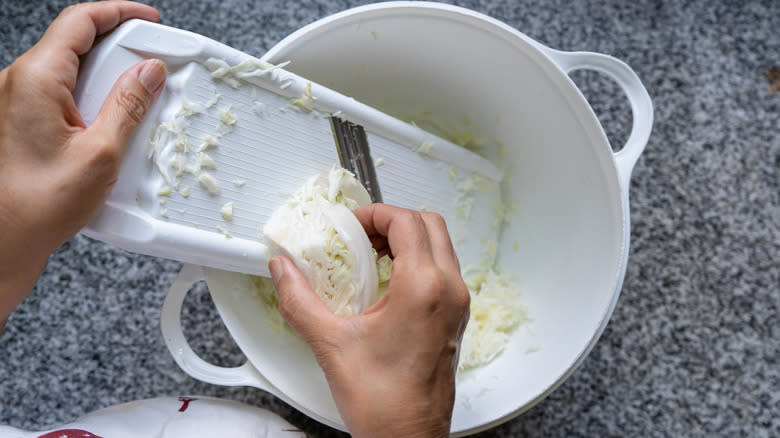
One of the worst things about making coleslaw is the shredding. If you don't have a food processor, breaking down your cabbage, carrots, and onions for this classic salad takes a lot of chopping time. Luckily, all of that is avoided when you're using a mandoline. This tool not only processes coleslaw pieces quickly, it also ensures that every one of your vegetables is cut to the same width and size. When they're combined, this means that every mouthful is uniform, with no chunky carrot batons or acrid lumps of onion. What's more, using a mandoline also means you get long, flexible slices, instead of squat little pieces.
Preparing your coleslaw veggies for slicing with a mandoline is largely the same as if you were cutting them with a knife. Ensure that your carrots are peeled, you've removed the core of your cabbage, and your onion skins are gone. When shredding your cabbage, make sure you cut it so that parts aren't poking over the sides. Otherwise, you'll end up with irregular slices, and a big gap in the center of the vegetable.
Use Your Mandoline To Make Vegetable Chips
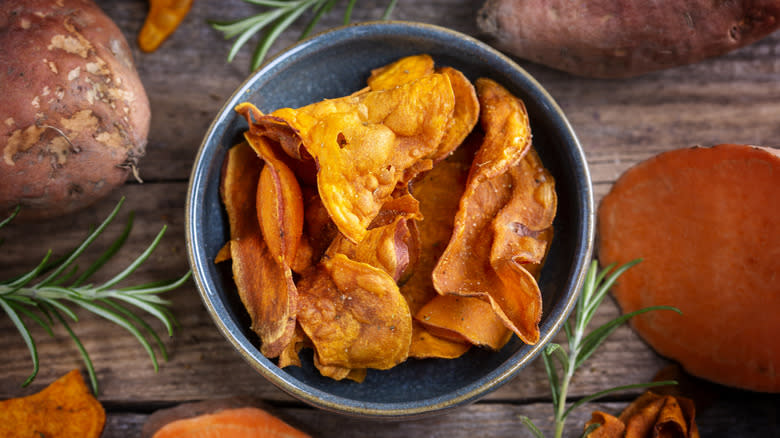
Vegetable chips are one of those snacks that people don't make often enough. That kind of makes sense: Not only do they seem like a lot of work, what with all that deep frying, they also require incredibly thin slices that are very difficult to achieve with a knife. Luckily, your mandoline makes things significantly easier. You can use pretty much any firm vegetable to make veggie chips with a mandoline, from beets to summer squash. You can even make your own potato chips using one (hey, don't judge -- it's a vegetable too)!
When making vegetable chips with a mandoline, make sure that they're all cut to the same size, to ensure that they cook evenly. You'll want to separate your vegetables by water content: If your produce has high natural moisture levels (like zucchini), you may need to salt them before cooking, so that they don't release all that water and ruin your chips' crispiness. If you're nervous about deep-frying, we've got you: Simply bake your veggie chips instead. When placed in a low oven and covered with a little oil, vegetable chips will get crispy in around 45 minutes. Hit them with a little sea salt and you're good to go.
Slice Vegetables For Your Ratatouille
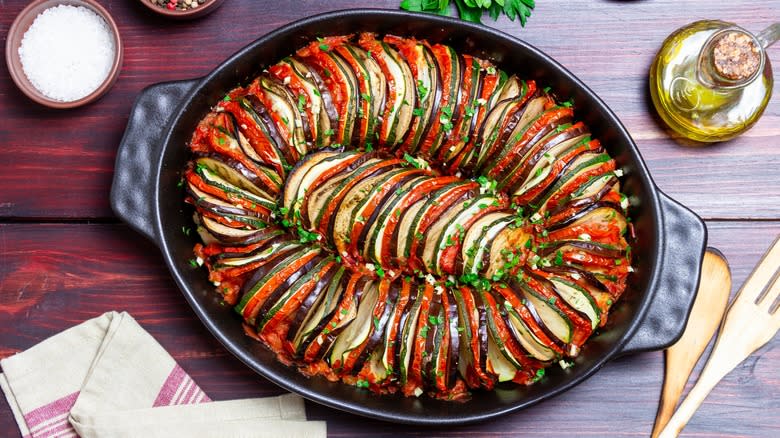
Ratatouille can be a thing of beauty. This mélange of peppers, tomatoes, eggplants, and zucchini is bright, colorful, and full of nutty, vegetal flavors. However, getting it right can take a lot of work, and for your flavors to be balanced and your meal to cook properly, each of your vegetables needs to be cut to the same size. That's where a mandoline comes in handy. Mandolines break down all your veggies to the same thickness, allowing you to produce an Instagram-worthy ratatouille where everything cooks at the same rate.
Just be aware of the texture differences of all of your vegetables. If you're layering sliced tomatoes into your ratatouille, use slightly firmer ones. Trying to slice ripe, mushy tomatoes with a mandoline will glom up your blade. The same thing can happen with ripe, soft bell peppers. When you're layering your ratatouille, make sure you're alternating your sliced vegetables, to give your dish even more visual punch and ensure that the flavors are well-distributed.
No Cheese Grater? Use Your Mandoline
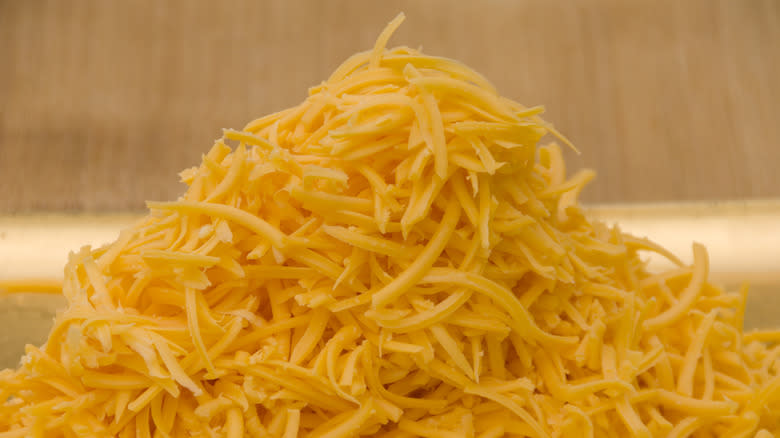
Your mandoline and your favorite cheese are a perfect pairing, especially if you need to grate it. A mandoline, after all, is very similar to a cheese grater; instead of loads of little perforations, though, you just have one single section to break it down with. This might sound like it makes things slower, but the result is that you can achieve super-long pieces of grated cheese, which can give your meal a certain aesthetic impact and make your cheese easier to handle. Plus, it allows you to customize the thickness of your cheese pieces, instead of having to put up with what the manufacturer of your cheese grater decided. Grating cheese with a mandoline will also give you better flavor and a better melt than buying prebagged grated cheese.
To grate cheese using a mandoline, make sure you're using your julienne or shredding blade. Cut your cheese pieces down to size before shredding them, so that you're not working with a huge, clunky block. It's also a good idea to use cold cheese, instead of cheese at room temperature. Warm cheese will soften up, making it harder to get consistent pieces and increasing the amount of mush around your blade.
Shred Carrots For A Carrot Cake

It doesn't take a genius to figure out that carrot cake requires carrots. Breaking those carrots down to size, however, is harder than it looks. While a food processor can do this easily, not everyone has one to hand, and shredding them with a box grater can be a messy, slow job.
That's why we recommend shredding your carrots with a mandoline. The main benefit of using a mandoline is the thinness you can achieve with your strips. Some mandolines can be adjusted to produce 1/16th-inch thick julienne strips. For carrot cake, this is essential: You're primarily looking for the flavor and color of carrots, not mouthfuls of hard, thick vegetable chunks. With this thickness, the carrot strips virtually melt into the batter.
When shredding your carrots with a mandoline, make sure you peel them first. Then, cut off their ends and run them gently but firmly over the blade attachment. Crucially, make sure you stop before your fingers get too close to the blade. Because carrots shred so smoothly with a mandoline, this can happen quicker than you think.
Cut Potatoes For A Gratin
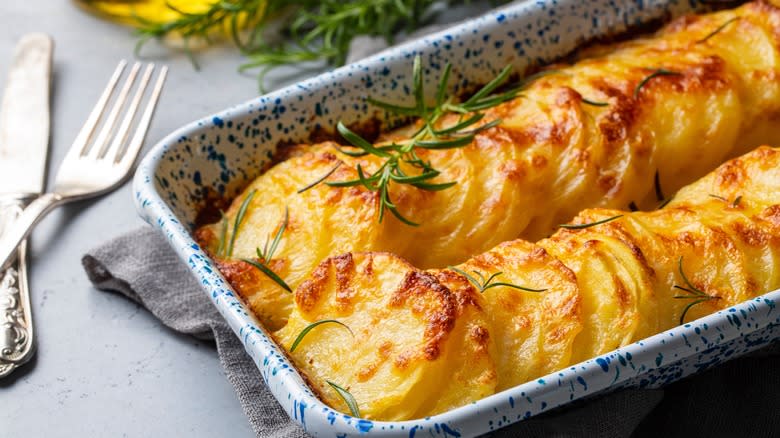
The joy of a well-made potato gratin is in the thickness of your potatoes. For the best balance of fork-tender potatoes to creamy dairy, your potatoes should be thin and uniform -- and nothing does that like a mandoline. Unless your knife skills are seriously on point, you'll inevitably end up with some slices that are thicker than others if you hand-slice your potatoes. This can cause notable inconsistency in your finished gratin, where some potatoes are cooked to perfection and others are burnt or still chalky.
Cutting potatoes with a mandoline also makes them look better. You don't have to cut a section off the bottom of your potato to make it lie flat, so you can slice it easily. Instead, all of your potato pieces will be gloriously round, and easier to layer on top of each other. Aside from this, using a mandoline is way faster than using a knife. Once you get the momentum going, you can slice up each potato in a matter of seconds. Just watch out for your fingers.
Grab Your Mandoline For Thin Egg Slices

Achieving ultra-thin slices of hard-boiled egg can be slightly tricky. If you don't have a sharp knife, eggs can put up a surprising amount of resistance, and this can cause them to tear or be cut irregularly. Add their slipperiness into the mix, and it can be a challenge to get perfectly round egg slices.
Not with a mandoline, though. These utensils are perfect for slicing eggs thinly and regularly, with the eggs putting up no fight against the razor-sharp blade. Many mandolines come with a slider attachment that can hold your eggs in place as they slice, which keeps them from slipping around in your fingers. It's usually best to use a mini mandoline, though; while you can use a full-size model, the handheld nature of mini versions means you can control your slices more accurately.
Once you have your egg slices, the world's your oyster. Tuck them into a pie or a lasagna, or layer them into a sandwich. Alternatively, you can place them delicately over an egg salad, to give a dish that's normally pretty rustic a gourmet appearance.
Use It To Shave Deli Meat
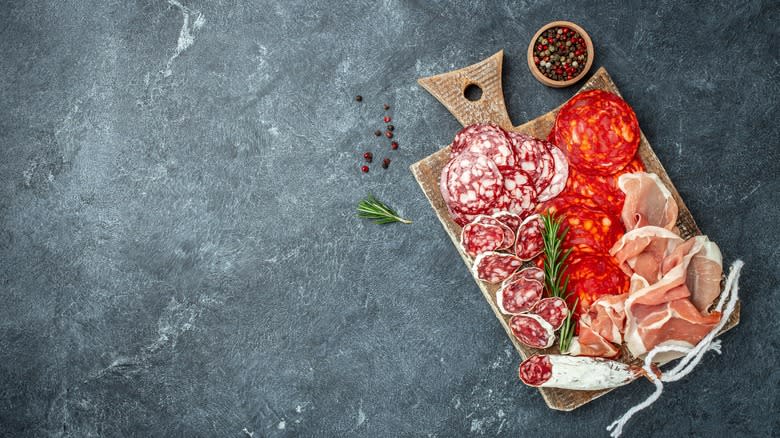
There's something about pre-packaged, pre-sliced deli meat that just doesn't hit the spot. These products are often fairly slimy, contain added water and preservatives, and taste pretty flavorless. We prefer buying whole pieces of deli meat (or making it ourselves) and slicing it at home. Mandolines are the perfect utensils for this, thanks to their ability to create super-thin slices quickly.
However, there are a few things to remember when using a mandoline to shave your deli meat. The first is the firmness of the meat itself. Slightly softer meats, like turkey, may be harder to slice and can bunch up on your blade. You should instead reserve your mandoline for hard-cured meats, like bresaola or chorizo.
Size can also be an issue here. If you're working with a huge hunk of meat and a small mandoline, you'll be unable to produce those big, wide slices you can buy at the store, which are usually produced with a commercial-grade meat slicer. Instead, aim for long, thin strips, and cut your meat down to size before you start slicing it. It should be able to sit flat on your mandoline's upper panel, with nothing poking over each side.
Easily Make Caramelized Onions With A Mandoline
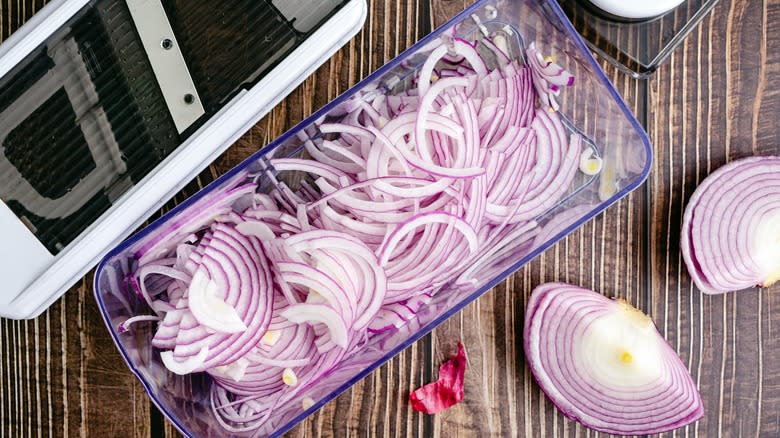
We all love caramelized onions, but not all of us love making them. Caramelized onions take a lot of time and work, and that work starts with slicing them. Not only do you have to slice a lot of onions for a relatively small end result (since they break down and shrink in your pan), you also have to make sure they're totally uniform. It's arguably the most important factor in your onions' success.
The easiest way to solve both of these issues is by using a mandoline. Mandolines ensure that each of your slices is cut to perfection, which means they'll all cook at the same rate. We would recommend setting your mandoline to a minimum ⅛-inch thickness. Any thinner and your onions can burn. While you can cut them slightly thicker, try not to go above ¼-inch, as this will just prolong your cooking time. Additionally, don't forget the biggest mistake you're probably making with caramelized onions: Even if they're sliced uniformly and thinly, they'll still need a good amount of time in your pan, to ensure that they break down into their full mushy, tangled, deep-brown glory.
Slice Your Eggplants For Eggplant Parmesan
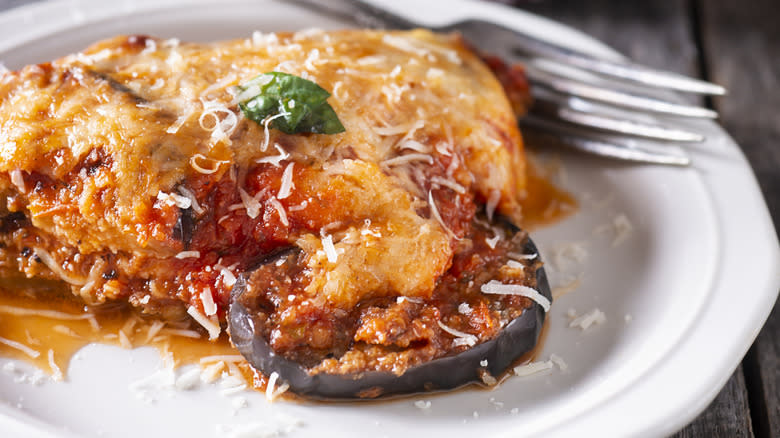
Slicing eggplants for an eggplant parmesan is annoying. There, we said it. The reason it's so irritating is all down to an eggplant's size. They're big, bulging, and clunky, and trying to cut the full length of them while maintaining the same thickness takes some serious knife skills. It also leaves you at risk of accidentally fumbling your slice.
Skip the hassle and use a mandoline. With a mandoline, you can get clean eggplant slices in seconds. Just place your eggplant lengthways on your utensil and slice smoothly. If round slices are more your thing, you can get those too: Just hold your eggplant at one end, and use your mandoline to skim off circular pieces.
Don't like eggplant? Use a squash instead! We're a big fan of zucchini parmesan, which is made with pretty much the same recipe -- simply swap out your main vegetable. You can even use yellow squash to make an alternative parmesan dish, with both zucchini and yellow squash slicing excellently with a mandoline. If you wish, you can also use sliced portobello mushrooms. We'd avoid slicing them with a mandoline, though, as they tend to be a little soft.
Cut Cucumbers And Onions To Make Tasty Tzatziki
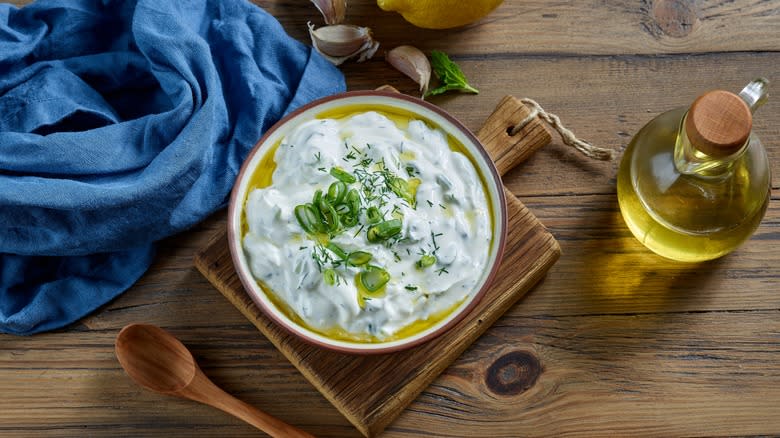
Not enough people make their own tzatziki. The thick, creamy blend of Greek yogurt, cucumbers, onions, and herbs is hardly difficult to make, and yet, most of the time, people resort to buying it from the store. Arguably, this is because slicing cucumbers and onions to the required thinness is a real hassle.
Not with a mandoline, though. By using the julienne attachment, you can break your cucumbers down to ultra-small strips, then follow up by using the regular blade to get wafer-thin onion slices. This thinness is beneficial to tzatziki as it allows the flavors of each vegetable to be distributed cleanly, creating a multi-layered dip that has maximum taste in each bite. Using thin slices of cucumber and onion (which are way trickier to achieve with a knife) also makes the tzatziki scoopable and spreadable.
If you like your tzatziki chunky, however, never fear. Instead of using your julienne attachment, just cut your cucumbers into strips, then slice them vertically to ¼ or ½-inch thickness.
Produce Ultra-Thin French Fries
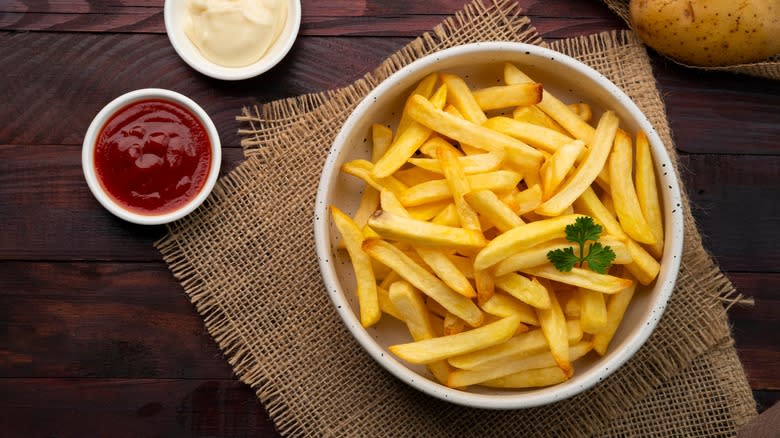
We can understand why people are reluctant to make french fries at home. Cutting them into matchstick-thinness can be tricky, and it takes way more time than throwing some frozen fries into the oven. With a mandoline, though, you can get super-thin French fries in no time. The easiest way to do this is to use a mandoline with a cross-cutting attachment. A ¼-inch measurement will give you thin fries that crisp up in no time. If you want, you can go even thinner to get shoestring fries.
If you only have a regular mandoline, you can still use it to speed up your preparation. First, slice your potatoes lengthways, to produce oval discs. Then, stack them back up on top of each other and slice them into fries. The first slicing stage will ensure that each fry is equally thick, which will help them cook more evenly. Doing this is also a great move if you want chunkier fries, as you can set your mandoline to ½-inch thickness, which will give you thick slices that you can use to make Parmesan steak fries.
Read the original article on Daily Meal

